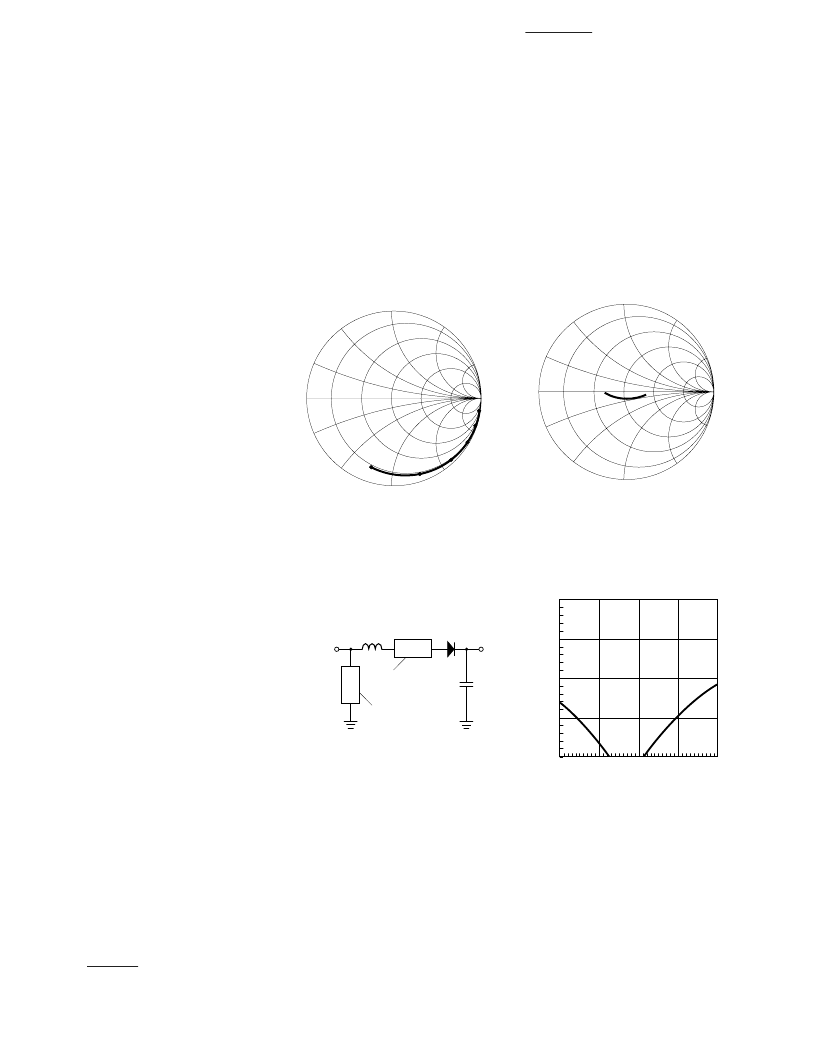- 您現(xiàn)在的位置:買賣IC網(wǎng) > PDF目錄370699 > HSMS-285A Surface Mount Microwave Schottky Detector Diodes in SOT-323(表貼型微波肖特基檢測二極管(SOT-323封裝)) PDF資料下載
參數(shù)資料
| 型號: | HSMS-285A |
| 英文描述: | Surface Mount Microwave Schottky Detector Diodes in SOT-323(表貼型微波肖特基檢測二極管(SOT-323封裝)) |
| 中文描述: | 表面安裝微波肖特基二極管探測器采用SOT - 323(表貼型微波肖特基檢測二極管(采用SOT - 323封裝)) |
| 文件頁數(shù): | 6/12頁 |
| 文件大小: | 117K |
| 代理商: | HSMS-285A |

6
I
S
+ I
b
R
V
≈
26,000
where
I
S
= diode saturation current
in
μ
A
I
b
= bias current in
μ
A
Saturation current is a function of
the diode’s design,
[4]
and it is a
constant at a given temperature.
For the HSMS-285A series, it is
typically 3 to 5
μ
A at 25
°
C. For the
medium barrier HSMS-2860 family,
saturation current at room
temperature is on the order of
50 nA.
Together, saturation and (if used)
bias current set the detection
sensitivity, video resistance and
input RF impedance of the
Schottky detector diode. Since no
external bias is used with the
HSMS-285A series, a single
transfer curve at any given
frequency is obtained, as shown in
Figure 4. Where bias current is
used, some tradeoff in sensitivity
and square law dynamic range is
seen, as shown in Figure 6 and
described in reference [3].
The most difficult part of the
design of a detector circuit is the
input impedance matching
network. For very broadband
detectors, a shunt 60
resistor
will give good input match, but at
the expense of detection
sensitivity.
When maximum sensitivity is
required over a narrow band of
frequencies, a reactive matching
network is optimum. Such net-
works can be realized in either
lumped or distributed elements,
depending upon frequency, size
constraints and cost limitations,
but certain general design
principals exist for all types.
[5]
Design work begins with the RF
impedance of the HSMS-285A
series, which is given in Figure 13.
Note that the impedance of the
HSMS-286A series is very similar
when bias current is set to 3
μ
A.
1 GHz
2
3
4
5
6
0.2
0.6
1
2
5
Figure 13. RF Impedance of the
HSMS-285A Series at -40 dBm.
915 MHz Detector Circuit
Figure 14 illustrates a simple
impedance matching network for a
915 MHz detector.
65nH
100 pF
VIDEO
OUT
RF
INPUT
WIDTH = 0.050"
LENGTH = 0.065"
WIDTH = 0.015"
LENGTH = 0.600"
TRANSMISSION LINE
DIMENSIONS ARE FOR
MICROSTRIP ON
0.032" THICK FR-4.
Figure 14. 915 MHz Matching
Network for the HSMS-285A
Series at Zero Bias or the
HSMS-286A Series at 3
μ
A Bias.
A 65 nH inductor rotates the
impedance of the diode to a point
on the Smith Chart where a shunt
inductor can pull it up to the
center. The short length of 0.065"
wide microstrip line is used to
mount the lead of the diode’s
SOT-323 package. A shorted shunt
stub of length <
λ
/4 provides the
necessary shunt inductance and
simultaneously provides the return
circuit for the current generated in
the diode. The impedance of this
circuit is given in Figure 15.
FREQUENCY (GHz): 0.9-0.93
Figure 15. Input Impedance.
The input match, expressed in
terms of return loss, is given in
Figure 16.
R
0.9
-20
FREQUENCY (GHz)
0.915
0
-10
-15
0.93
-5
Figure 16. Input Return Loss.
As can be seen, the band over
which a good match is achieved is
more than adequate for 915 MHz
RFID applications.
[4]
Hewlett-Packard Application Note 969,
An Optimum Zero Bias Schottky Detector Diode.
[5]
Hewlett-Packard Application Note 963,
Impedance Matching Techniques for Mixers and Detectors.
相關PDF資料 |
PDF描述 |
|---|---|
| HSMS-286A | Surface Mount Microwave Schottky Detector Diodes in SOT-323(表貼型微波肖特基檢測二極管(SOT-323封裝)) |
| HSMS-286K | Surface Mount RF Schottky Detector Diodes in SOT-363(表貼型射頻肖特基檢測二極管(SOT-363封裝)) |
| HSMS-286L | Surface Mount RF Schottky Detector Diodes in SOT-363(表貼型射頻肖特基檢測二極管(SOT-363封裝)) |
| HSMS-286P | Surface Mount RF Schottky Detector Diodes in SOT-363(表貼型射頻肖特基檢測二極管(SOT-363封裝)) |
| HSMS-286R | Surface Mount RF Schottky Detector Diodes in SOT-363(表貼型射頻肖特基檢測二極管(SOT-363封裝)) |
相關代理商/技術參數(shù) |
參數(shù)描述 |
|---|---|
| HSMS-285ASERIES | 制造商:未知廠家 制造商全稱:未知廠家 功能描述:Surface Mount Microwave Schottky Detector Diodes in SOT-323 (SC-70) (155K in pdf) |
| HSMS-285B | 制造商:HP 制造商全稱:Agilent(Hewlett-Packard) 功能描述:Surface Mount Zero Bias Schottky Detector Diodes |
| HSMS-285B-BLK | 制造商:HP 制造商全稱:Agilent(Hewlett-Packard) 功能描述:Surface Mount Zero Bias Schottky Detector Diodes |
| HSMS-285B-BLKG | 功能描述:射頻檢測器 RF/ID below 1.5GHz RoHS:否 制造商:Skyworks Solutions, Inc. 配置: 頻率范圍:650 MHz to 3 GHz 最大二極管電容: 最大工作溫度:+ 85 C 最小工作溫度:- 40 C 封裝 / 箱體:SC-88 封裝:Reel |
| HSMS-285B-G | 制造商:Avago Technologies 功能描述:HSMS-285B zero-bias Schottky detector |
發(fā)布緊急采購,3分鐘左右您將得到回復。